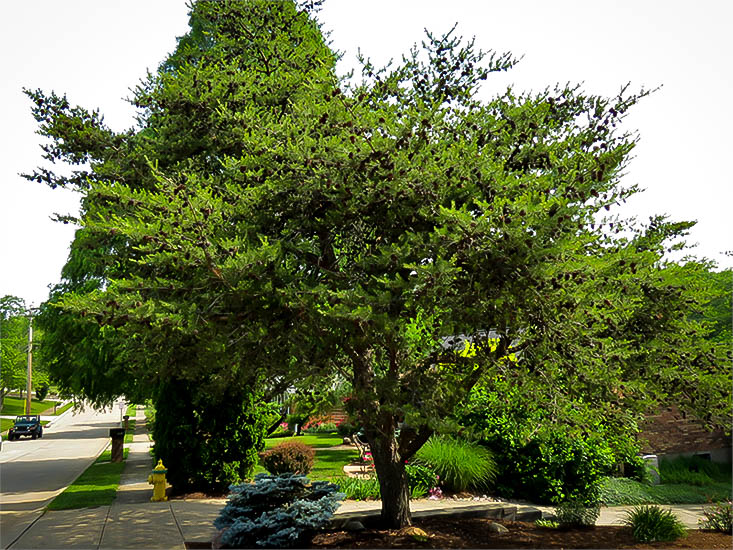
Virginia Pine Tree - Pinus Virginiana And It's Benefits
Virginia Pine Tree - Pinus Virginiana And It's Benefits
The Virginia pine tree is a medium-sized tree, regularly found on more deficient soils from Long Island in southern New York south through the Appalachian Mountains, western Tennessee, and Alabama.
The standard size range for this pine is 9–18 meters. However, they can develop taller under ideal conditions. Their average growth rate is 8 to 12 inches per year but can also vary. These trees are typically found and planted in zones 5 through 8. The trunk of the trees can be as big as a half-meter. Virginia pine trees prefer depleted topsoil or dirt yet can develop on impoverished, sandy soil, where it stays little and hindered. The ordinary life expectancy is 65 to 90 years. The short (4–8 cm) yellow-green needles are matched in bunches and are frequently curved. Pine cones are 4–7 cm long and may survive on the tree for many years, frequently discharging their seeds in the second year. A few trees might be slanted with bent trunks during the growth process. Virginia pine trees are essentially utilized as obstructions and naturalized woods. They are inadequate trees with minimal elaborate interest. This pine is valuable for reforesting and gives sustenance to wildlife. Its other principal use is on Christmas tree branches, despite having sharp-tipped needles and yellowish winter shading. It can additionally be used as wood mash and timber. Like some other southern yellow pines, Virginia Pine lumber tends to solidify. It tends to become highly hardened after some time amid wood drying. Wood from Virginia pine is not ordinarily considered to oppose decay unless treated with additives. The Virginia pine tree is a perennial tree, meaning it lives for different years. They are additionally gymnosperms. Gymnosperms deliver seeds, but they don't ensure them with an ovary or with fruits.
Virginia Pine Tree - Pinus virginiana
Virginia Pines are not limited to Virginia. These hardy trees can survive poor soil conditions from New York to Alabama. Frigid winters, sandy soils, and microscopic nutrients will not stop these trees from growing. It will, however, stunt their growth. The favored soil of Virginia Pines is loam or clay soil. These soils will produce trees reaching up to 75 feet in height. In the first year, seedlings with well-drained, loamy soil can grow from 4-8 inches. By age 50, mature trees can be between 50 and 75 feet tall. These trees have an expected lifespan of 65-90 years. The quick growth rate, ease of reforestation, and hardening of the cut wood during the drying process make this a helpful lumber. Virginia Pines are very popular in the southern states for use as Christmas trees. These trees can be ready for harvest in as few as three years with optimal growing and pruning conditions. Five years is usually preferred so the trees will be thick, paired needles on long spreading limbs.
Since these hardy trees are pest-resistant and tolerate poor soil conditions, they are favored by landscapers for bonsai use, median barriers, and seaside homes. These trees often reforest barren areas where fire or mining has destroyed the landscape. These pines will grow thick and significant at the perimeters of a yard and are regularly pruned, making a beautiful natural boundary. The wood of a Virginia Pine will soften as the tree ages. Bird-lovers allow older trees to remain on their property so they will attract woodpeckers. Some people also use stands of trees to create a natural privacy fence around their home or property. Virginia Pines are shipped as bare-root plants to customers.

Virginia Pine Seedlings Virginia Pine Seedlings-Pinus Virginiana. Virginia Pine Seedlings are the seed or baby of the Virginia Pine tree, which is an evergreen that is a perennial. These seedlings will become a Virginia Pine tree that can stand as tall as 59 feet high. They start very small and thin, and it takes a lot of time for the seedling to become an adult tree. This period depends on the conditions of the soil. They thrive in more clay-type soil and tend to have stunted growth in other types of soils. The overall life span is around 60 to 90 years, from seedling to adult. These seedlings are commonly found in the United States, where there is clay or sandy soils. As the seedlings grow and mature, the unruly rugged growth habit of the tree will begin to show. In the Southern parts of the United States, this tree is grown and used for Christmas trees. Most like to plant the seedlings and allow them to grow to begin to fill in and start natural forest areas with their rugged scraggly appearance. The needles are short, and the cones are small, ranging from 1,2 or 3 inches long with sharp tips at the end of the pedals of the cone. These seedlings can be planted and grown by anyone; however, it is not recommended for yard or curb appeal because of their out-of-control look. If you want to fill in an empty field area or start a Christmas tree farm, these are the seedlings to get the job done. Once planted, it is good to keep them watered. When the tree starts to come up, it is a good idea to put a strong stick in the ground next to it to keep the baby tree propped up until it has the strength to stand straight up on its own. Once it can stand on its own, the rest is history, and there is no need to continue care. It can survive on its own in the natural elements. So the next time you see a Christmas tree, remember the Virginia Pine Seedlings.






